When we discuss firearms in Forensic Medicine we are mainly concerned about the effect of firearms on human bodies, especially the information that can be collected from a wound about the firearm used and the manner in which it has been used to aid in the judicial procedures.
To discuss it any further we need to understand the firearms first —
A firearm is essentially a device that accelerates a projectile towards a target by means of energy generated from chemical reactions, usually a contained explosion.
The movement of the projectile (aka the bullet) can be divided in three parts —
- Internal ballistics : This is the path of the bullet before it leaves the muzzle. We will discuss it when talking about the inner workings of firearms.
- External ballistics : This is the path of the bullet from leaving the muzzle to reaching its target.
- Wound ballistics : This is the path of the bullet inside the human body if it hits one. This is what we are most interested in.
Types of Firearms
There are three types of firearms that we need to be concerned about —
- Rifled firearms : This type of firearms has spiral grooves cut into the inside of the barrel called rifling. It helps in rotating the bullet very fast as it leaves the muzzle. It helps to increase accuracy and effective range by means of gyroscopic stability of the bullet.
- Shotguns : These are smooth bore firearms, meaning they don't have any rifling. They usually fire multiple small pellets at the same time. It helps in acquiring the target easily by spreading the projectiles on a wider front at the cost of the range.
- Handguns : They are smaller versions of rifled firearms meant for easy carrying. E.g. pistols, revolvers etc. Their smaller barrel length limits their range and they are usually low powered than their bigger counterparts.


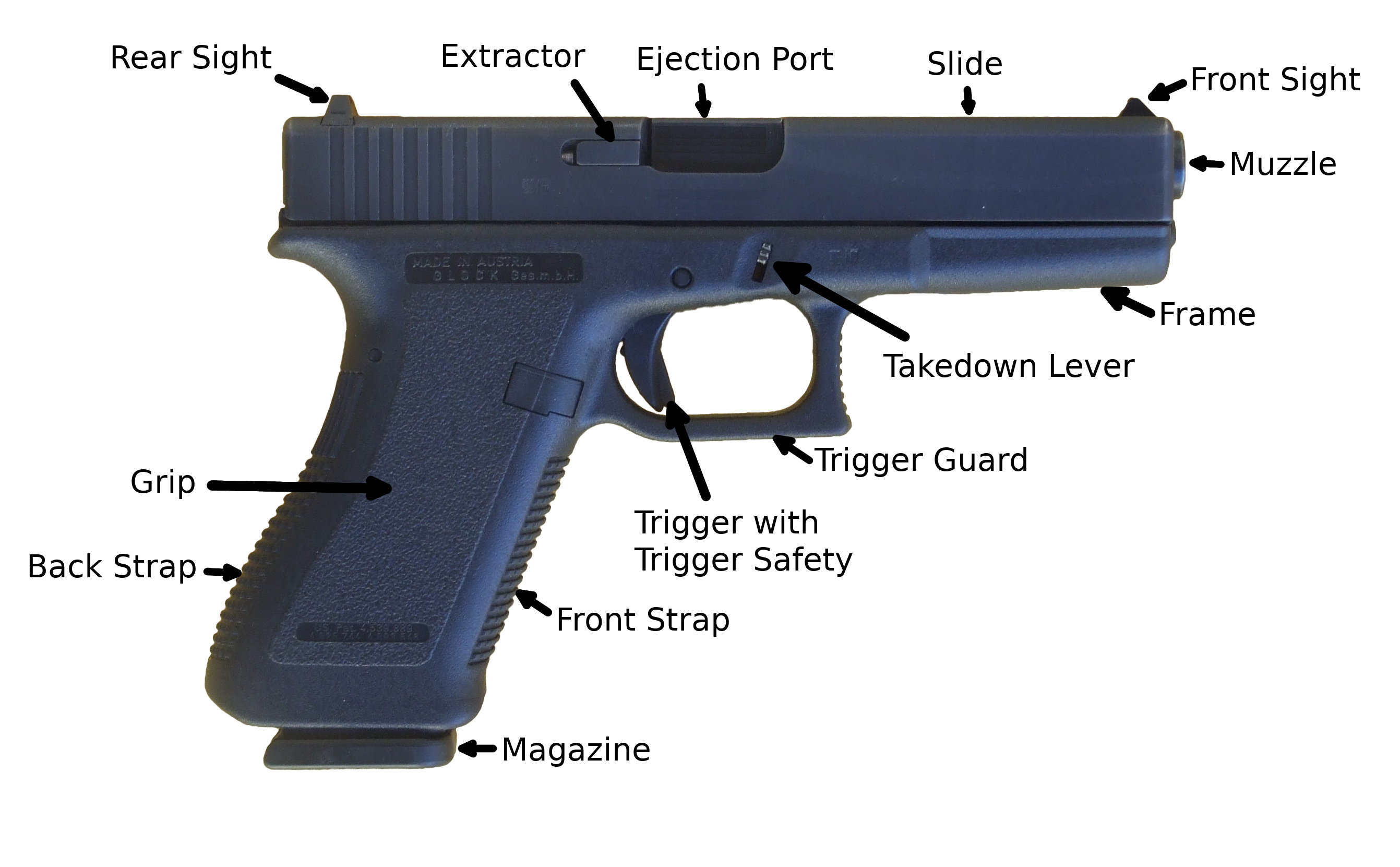
Other types of firearms include gyrojet guns (propellant charge contained in the bullet), paradox guns (shotgun with terminal rifling) etc.
Some similar weapons, but not technically firearms, are airguns, stud-guns etc.
Insides of a firearm
A firearm has four essential components —
- Ammunition
- Chamber
- Firing mechanism
- Barrel
We will discuss them one by one.
Ammunition
They are usually called cartridges which is essentially a self-contained package of the primer, charge and bullet.
| Rifled firearms | Shot guns |
|---|---|

|
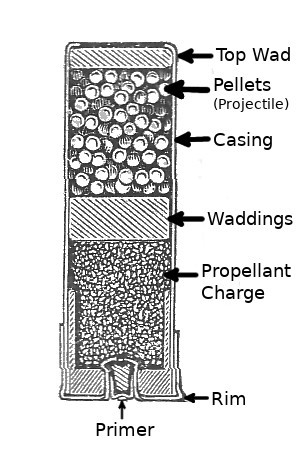
|
|
They can have three types of bullets —
|
They may have three types of projectiles —
|
| The projectile (bullets, shots etc.) is usually made from lead or lead-antimony alloy due to their high sectional density and malleability. Some bullets may contain a metal jacket which is usually made of cupro-nickel, copper-zinc or steel. | |
| The primer is a pressure sensitive material contained within a cap. It ignites when hit by a firing pin and in turn ignites the propellant charge. It contains either a mixture of mercury fulminate, potassium chloride and antimony sulphide or a mixture of antimony sulphide, lead styphnate, lead peroxide and barium nitrate or tetracene. | |
| Propellant charge is usually composed of smokeless powder. It may be single base (nitrocellulose) or double base (nitrocellulose + nitroglycerine). Previously black powder was used as propellant charge. Smokeless powder produces 800 ml - 900 ml of gas per grain whereas black powder produces only 200 ml - 300 ml of gas per grain. | |
| Casing is usually made from metal, paper or plastic. It encloses the cartridge and also seals the breech after firing to prevent the gas from escaping. | |
There are some special types of bullets —
- Hollow point bullet : This is a type of semi-jacketed bullet that has a hole drilled into its nose. The hole causes greater expansion of the bullet upon hitting the target and causes more tissue damage.
- Dumdum bullet : This type of bullets are made by cutting the nose of a jacketed bullet, that essentially makes them semi-jacketed bullets.
- Incendiary bullet : These bullets have combustible substances in their tips. Usually white phosphorus is used. They are used to hit flammable targets like oil tanks.
- Tracer bullet : These bullets have some brightly illuminating substances added to them which light up when fired. They are used to visualize the trajectory the bullets are taking.
- Explosive bullet : These bullets have a explosive substance inserted into their tips, usually lead azide. It causes greater fragmentation if it explodes upon impact.
Chamber
This is the part of the firearm where the cartridge is placed before firing. It is made very sturdy so that it can withstand the force of the explosion while firing each round. The rear of the chamber is covered by breech plate which contains an opening through which the firing pin can strike the primer cap of the cartridge.
Firing mechanism
It contains a spring loaded hammer or a striker which hits the firing pin when the trigger is pulled. The firing pin hits the primer cap behind the cartridge in the chamber and causes the primer to ignite, which in turn ignites the propellant charge and the rapidly expanding hot gas produced by its explosion propels the bullet through the barrel.
Barrel
| Rifled firearms | Smooth bore firearms |
|---|---|
| (E.g. rifles, pistols, revolvers etc.) | (E.g. shotguns, muskets etc.) |
| The barrel has spiral grooves cut into its inside called rifling. The device used to create rifling is called a broach. | No such rifling. |
| It has almost uniform diameter throughout its length. | The end of the barrel may have a tapering called choking. |
| The rifling causes the bullet to spin very fast along its long axis, the resulting gyroscopic stability stabilizes the bullet's flight path and increases the effective range and accuracy of the firearm. | The choking increases the effective range of a shotgun by pushing the pellets together as they exit the muzzle and delaying their dispersal. Shotguns may have different types of choking, e.g. no choking, half choking (20/1000th of an inch), full choking (40/1000th of an inch) etc. |
| The caliber is measured by the inner diameter of the barrel, more specifically the distance between two lands. E.g. 7.62 mm rifle, 9 mm pistol etc. | The caliber is measured by gauge which is defined as the number of snugly fitting lead balls needed to make a single ball of 1 pound weight. So higher gauge means smaller caliber. E.g. 20 G shotgun. |
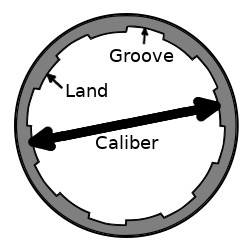
|

|
A firearm usually has some other parts as well —
- Magazine : They hold extra rounds ready to be loaded into the chamber.
- Loading mechanism : It helps to load the cartridge into the chamber before firing and also loads the spring of the firing pin. It can be of different types, e.g. bolt action (rifles), slide action (pistols), pump action (shotguns) etc. Revolvers have multiple rotating chambers. Each of these can be manual, semi-automatic or automatic.
- Ejection mechanism : They are usually coupled with the loading mechanism, they eject the spent cartridge after firing a round.
- Sight : Usually a fore sight and a rear sight is placed in the muzzle end and the breech end of a firearm respectively. Some rifles may contain telescopic sights. They help in aiming the firearm.
When multiple bullets are fired simultaneously they are called tandem bullets. They can be of two types. If two bullets are inserted in the same cartridge it's called a duplex cartridge. Sometimes a bullet fails to come out of the muzzle and is ejected during the subsequent shot along with the next bullet, it's known as piggy-back bullet. Tandem bullets pose a problem because they can be mistaken as multiple gunshot wounds.
External ballistics
A bullet gains its kinetic energy from the explosion of the propellant charge inside the chamber and accelerates down the barrel. After exiting the muzzle it decelerates due to air drag. The gravity also pulls it downwards causing it to drop towards the ground (called bullet drop).
A rifled firearm imparts rapid rotation to the bullet. This helps in stabilizing the flight path of the bullet by means of gyroscopic stability. It improves accuracy and range.
A bullet can hit an object and get reflected and hit another target. This is known as ricochet bullet. A ricochet bullet can potentially hit the person who fired it.
A yawning / wobbling bullet moves in an irregular fashion, whereas a tumbling / somersaulting bullet rotates in its longitudinal axis.
The pellets of a shotgun starts to disperse after travelling a short distance from the muzzle, it helps in acquiring the target but also reduces the range. The choking of a shotgun delays the dispersal of pellets and increases the range.
Wound Ballistics
This is the part we are most interested in. Firearm wounds are usually penetrating wounds. We can derive information about the range and type of firearm by examining the features of the wound.
A bullet causes three types of injury if it hits human tissue —
- The surface wound : The entry and the exit wounds, they are the most informative wounds while examining a victim of a gunshot. The exit wound may not always be present if the bullet is lodged inside the body.
- The permanent cavity : This wound is caused by direct crushing of tissues by the bullet as it travels inside the body. The expanding bullets (e.g. hollow point bullets) create a permanent cavity larger than their own diameter. If a bullet is fragmented upon impact (e.g. frangible bullet) it can cause multiple permanent cavities.
- The temporary cavity : As a bullet travels inside a body it transfers its kinetic energy to the surrounding tissue causing a radial shock wave. This shock wave can damage nearby tissues even if they are not directly crushed by the bullet.
Tissue damage due to a gunshot injury is proportional to the kinetic energy of the bullet.
`"Kinetic energy" = 1/2 × "mass of bullet" × ("velocity of bullet")^2`
So if velocity is doubled the damage done by the bullet may be quadrupled.
The damage done by the bullet also depends on the tissue it hits. Soft tissue adsorbs little energy from the bullet and the bullet may pass through it causing little damage, whereas tough structures like bones may absorb most of the bullets energy and result in massive damage like comminuted fracture of bones.
Entry wound
An entry wound is present where the bullet enters the body. It's usually smaller than the diameter of the bullet due to elasticity of skin. It's typically inverted and circular, but may be tear drop shaped if it hits the body in an angle or can be slit like if the bullet is tumbling.
The secondary products of firing e.g. unburned powder, smoke, flame etc. may leave their marks on the entry wound which helps in determining the range. On x-ray a metallic ring shadow may be seen at the wound of entry.
It's the most informative wound of all gunshot wounds and can provide information about the type of firearm used, its range etc. The entry wound varies widely between rifled firearms and shotguns, so we will discuss them separately.
Rifled entry wound
The range is usually determined by the effects of secondary products of firing on the entry wound or on the clothing covering the area.
| Range | Distance | Product | Wound features | |
|---|---|---|---|---|
| Rifle | Handgun | |||
| Distant | >100 cm | >50 cm | Bullet only | Abrasion collar + Grease collar |
| Intermediate | 60 cm - 100 cm | 40 cm - 50 cm | Bullet + Unburned powder | Abrasion collar + Grease collar + Tattooing / Peppering / Powder stippling |
| Near | 15 cm | Bullet + Unburned powder + Smoke / Soot | Abrasion collar + Grease collar + Tattooing + Blackening / Smudging | |
| Close | 8 cm | Bullet + Unburned powder + Smoke + Flame / Hot air | Abrasion collar + Grease collar + Tattooing + Blackening + Burning / Scorching + Singing of hair | |
| Contact | 0 cm | All products enter the wound |
|
|

Courtesy: Bobjgalindo (GFDL)
Contact shot on head causes a cruciate or stellate wound due to the high pressure gas escaping through the loose areolar tissue.
Cherry red discoloration may be seen in contact, close and near ranges due to the formation of carboxy-hemoglobin formed due to reaction between carbon-monoxide in the exhaust gas and the hemoglobin in the tissue.
Point blank range is an arbitrary term that indicates a range in which it is not possible to miss the target.
Use of silencers on a firearm can significantly change the features as it suppresses the secondary products of firing from exiting the muzzle, thus making it difficult to determine the range.
The most reliable way to determine the range is to test fire the suspect weapon at ballistic gel at different ranges and comparing the features with the victim's wound.
The direction of the wound may sometimes be determined from the wound of entry. In perpendicular shots the wound is circular and the abrasion collar evenly distributed around the wound. But in angled shots the wound is more tear drop / egg shaped and the direction is indicated by the presence of abrasion collar to that side. The distribution of secondary products of firing also helps in determining the direction.
Shotgun entry wound
Shotguns usually use multiple pellets as projectiles. The pellets disperse as they exit the muzzle of the shotgun. The range of firing can be determined by the dispersal of the pellets.
| Range | Dispersion | Wound |
|---|---|---|
| 0 m - 2 m | No dispersion | Single wound of entry (rat hole / cookie cutter / scalloping / nibbling) |
| 2 m - 4 m | Partial dispersion | Main wound of entry + Satellite wounds |
| >4 m | Complete dispersion | Multiple wound of entry |
The range of the shotgun can be measured more accurately by measuring the spread of the pellets. But it also depends on the choke used in the shotgun.
- No choke : `"range in yards" = 2/3 × "spread in inches"`
- Half choke : `"range in yards" = "spread in inches"`
- Full choke : `"range in yards" = 4/3 × "spread in inches"`
The range can also be determined from the effects of secondary products of firing on the wound of entry.
| Range | Distance | Product | Wound features |
|---|---|---|---|
| Distant | >90 cm | Pellets only | Wound of entry only |
| Intermediate | 60 cm - 90 cm | Unburned powder | Tattooing / Peppering / Powder stippling |
| Near | 30 cm | Unburned powder + Smoke / Soot | Tattooing + Blackening / Smudging |
| Close | 15 cm | Unburned powder + Smoke + Flame / Hot air | Tattooing + Blackening + Burning / Scorching + Singing of hair |
| Contact | 0 cm | All products enter the wound | Similar to rifled firearm wounds. Also the wad is embedded into the wound. |
The wadding of the shotgun shell may also leave an abrasion mark if hits the skin within 10 ft - 12 ft. Some shotgun shells have a plastic covering known as power piston around the pellets to prevent early dispersal and it opens after travelling a short distance from the muzzle. If it hits the skin after opening it may leave a cruciate abrasion, which may be seen in ranges of 60 cm - 90 cm.
The direction of firing may be determined by the spreading of the pellets. The pellets are evenly distributed in perpendicular shots, but in angled shots they are more closely packed closer to the gun and more widely dispersed to the opposite side. Also the pattern of tattooing and blackening may indicate the direction. But it becomes unreliable on increased ranges.
Exit wound
Exit wound is seen where the bullet leaves the body. It is most commonly seen in case of rifled firearm injuries.
The exit wound is usually everted and larger than the wound of entry. There is usually protrusion of subcutaneous fat through the exit wound. Bleeding is usually more in the exit wound than the entry wound. But in case of long distance shots, low velocity bullet or ricocheted bullets the entry wound may be larger than the exit wound.
If the skin is supported by some hard surface, e.g. the victim leaning on a wall, the exit wound may have abrasion around the wound margin due to crushing of tissue between the bullet and the hard surface. This type of exit wound is called shored exit wound.
Exit wounds are usually not seen in shotgun wounds as the pellets quickly looses their kinetic energy after hitting the body. Exit wounds in a shotgun injury can only be seen in case of a contact shot.
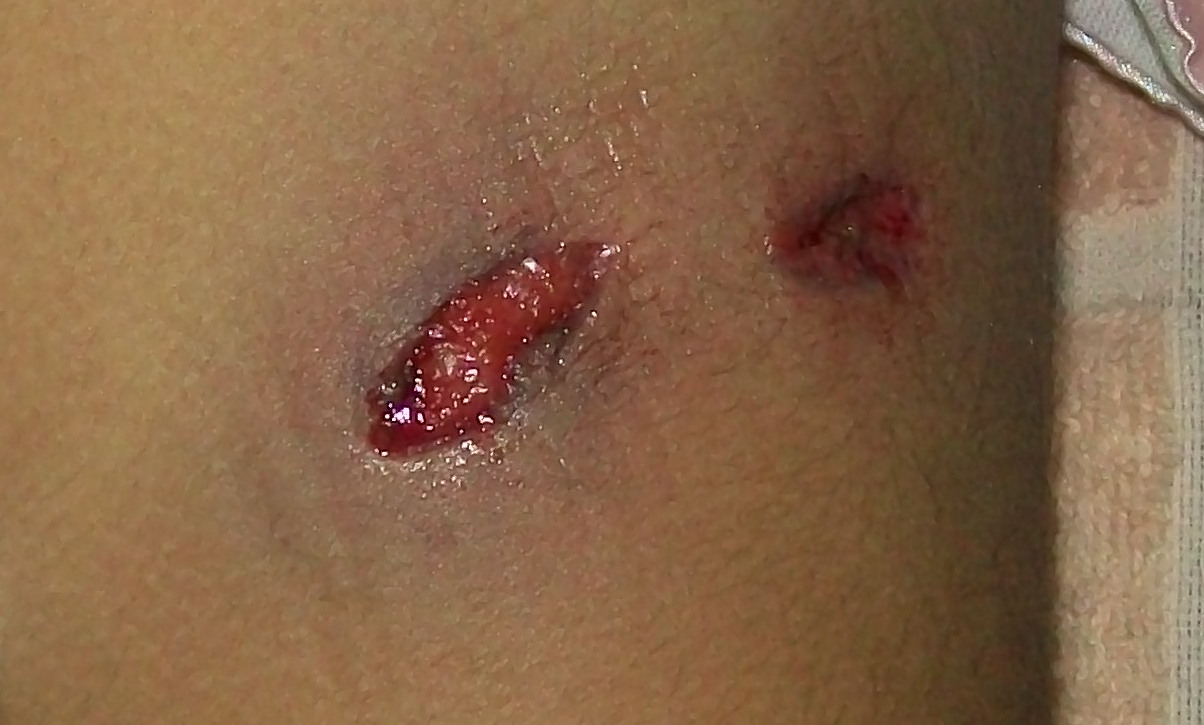
Courtesy: Bobjgalindo (GFDL)
Track of the wound
The track taken by the bullet inside the body causes the permanent cavity. There may be single or multiple tracks depending on the fragmentation of the bullet. It may pass through different organs and vessels causing organ damage and internal hemorrhage. If the bullet hits a bone, the fracture fragments may act as secondary missiles creating their own tracks and causing additional injuries to internal structures. Pieces of fabrics may be pushed into the wound by the bullet if the area is covered by clothing. In case of shotgun wounds the pellets usually take divergent tracks inside the wound. Sometimes a bullet already in the wound may be hit by a second bullet and go on a different trajectory, it is known as billiard board ricochet bullet and causes additional damage.
Sometimes direction of the firing may be determined by the direction of the wound track, but it may give false results in case of bullets changing direction in wound, fragmentation, secondary missiles like bone splinter, divergent course taken by pellets etc.
In case of fragmented bullets, the fragments may be detected by performing an x-ray of the affected area. The peculiar appearance of the fragmented bullet in a x-ray is known as lead storm phenomenon or the birdshot pattern.
Wound peculiarities
No exit wound is found if —
- Bullet lodged inside the body.
- Bullet expelled by a natural orifice, e.g. passed with stool, coughed out etc.
- Bullet reflected by a bone and exited through the wound of entry.
One wound of entry but two bullets found inside the body —
- In case of tandem bullets.
- Successive firing of the firearm without any change of position.
- If a bullet fragments into two.
One wound of entry but multiple wound of exit —
- In case of tandem bullets.
- Successive firing of the firearm without any change of position.
- If a bullet fragments into two.
- If a splinter from a fractured bone exits the body.
No exit wound but no bullet inside body —
- Bullet expelled by a natural orifice, e.g. passed with stool, coughed out etc.
- Bullet reflected by a bone and exited through the wound of entry.
Multiple wound of entry but only one bullet inside body —
- One of the bullets expelled by a natural orifice, e.g. passed with stool, coughed out etc.
- One of the bullets reflected by a bone and exited through the wound of entry.
- When one bullet penetrates multiple parts of the body, such as a bullet entering lateral aspect of arm, exiting through medial aspect of that arm, entering lateral aspect of chest wall and then exiting through the other side of the chest wall. In such a case there may be multiple wounds of entry and multiple wounds of exit by the same bullet.
Gunshot injury to skull
Gunshot injury to skull causes some peculiar features of entry and exit wounds —
| Entry wound | Exit wound |
|---|---|
| (Punched in hole) | (Punched out hole) |
| Sharp wound margin in outer table. | Bevelling / crater like wound in outer table. |
| Bevelling / crater like wound in outer table. | Sharp wound margin in inner table. |
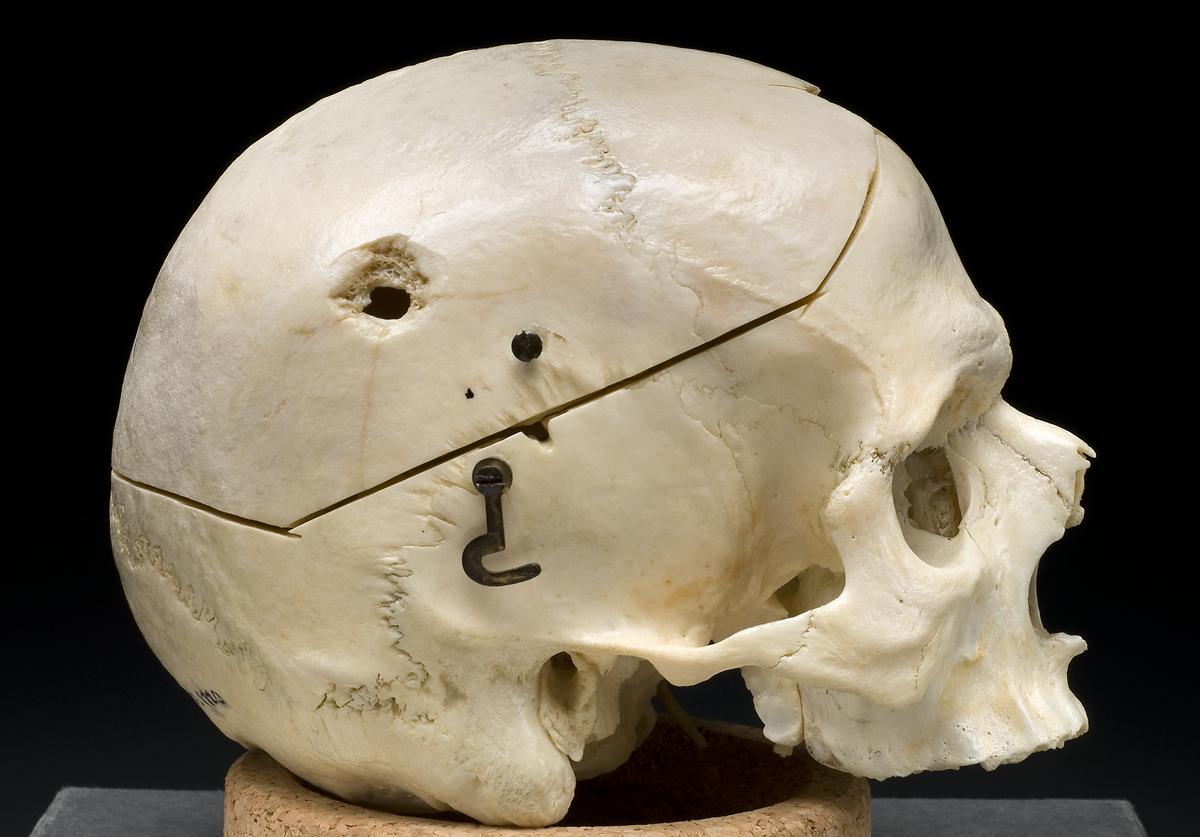
When a high velocity bullet enters the skull it may cause the skull to burst open causing evisceration of brain, this is known as a Kronlein shot.
A bullet may sometimes graze the skull causing a gutter fracture of the outer table with the inner table left intact. The surface presentation of such an injury may be a slit like or keyhole wound, which is essentially a combined entry and exit wound.
Gunshot wounds to the skull may cause radial fractures around the entry wound. Puppe's rule states that a fracture line will not cross an already existing fracture line. Using this rule it is possible to determine the sequence of shots in case of multiple gunshot injuries to the skull.
Cause of death in gunshot injury
The death in a gunshot injury may be early or late.
The early cause of death includes —
- Hemorrhage from the wounds, which may be external or internal.
- Shock, may be hypovolemic or neurogenic.
- Damage to vital organs, e.g. brain, heart etc.
- Embolism due to fat, air etc. entering the blood stream.
- Asphyxia due to blocking of airway by bullet, blood etc.
The late causes may be —
- Infection from the wound, may cause sepsis.
- Stricture of vital structures such as esophagus.
- Lead poisoning from a bullet lodged inside the body.
Examination of the victim
Living victim
General examination of the victim is to be done first.
Further detailed examination should be done preferably on the O.T. Table. The part involved, the extension of the damage and severity of the injuries are to assessed thoroughly. A radiological investigation is also recommended.
Bullets are extracted surgically through a skin incision separate from the wound of entry. Surgical intervention through the wound of entry may give rise to confusion about the trajectory of the bullet which is known as Kennedy phenomenon. If a lodged bullet is compatible with life and it's removal may cause extensive damage then it is left in place. Such a bullet is called souvenir bullet.
The clothing of the victim is also examined for bullet holes, blood stains etc. The examination of the place of occurrence is also important.
Post-mortem
The post-mortem of a gunshot victim is performed similar to the general post-mortem, but the following examinations are done in addition to that —
- Examination of clothing for bullet holes, blood stains etc.
- Line of flow of blood from the wound.
- Any secondary injuries.
- Wounds of entry and wounds of exit.
- Direction of firing from abrasion collar, dispersal of pellets, secondary products of firing etc.
- Track of the wound is to be traced.
- Bullets are removed with a rubber tipped forceps or with the tips of the fingers. After removal some identifying marks are engraved behind the bullets. The bullets are preserved with the blood stains in a sealed and labelled glass jar after covering them in cotton. The pellets are treated similarly except no engraving is necessary. Bullet fragments are also preserved.
- Skin around the wound is preserved for chemical identification of unburned powder, grease etc.
Determining nature of death
Death from firearm injury may be suicidal, homicidal or accidental.
Suicidal gunshot wounds are on easily reachable sites of body such as palate, below chin, right or left temple or medial canthus of eye (depending on the handedness), forehead or pre-cordial area. Usually one round is fired but sometimes multiple rounds may be fired often without changing position of the weapon. They are often contact shots or close shots. The weapon found in the cadaveric spasm in the victim's hand is a strong indication of suicidal nature of death. Other suggestive evidence may include latent fingerprints, dermal nitrate test of the victim's hand, secluded spot, doors closed from inside, suicide note etc.
Homicidal gunshot wounds can be anywhere in the body and can be from any range. Multiple wounds of entry from contact or close range placed in the back of the victim is certainly homicidal. Often the weapon is absent but sometimes they maybe placed in the victim's hand, but in such cases cadaveric spasm will be absent.
Accidental gunshot wounds maybe caused by wrong aiming or mishandling of the weapon. They can simulate either suicidal or homicidal wounds. Careful examination of the circumstances are necessary to avoid confusion.
Examination of the place of occurrence
The approachability of the place is to be noted as it is important in determining the nature of death. Disorder in the place may be indicative of a struggle which is suggestive of homicide. Empty cartridge, extra bullets, bullets marks are also to be looked for. Sometimes the weapon of offence may be found at the scene. Latent fingerprints and footprints may be recovered. The pattern of shedding of blood is also important.
Identification of firearm
The identification of the firearm is usually done from the features of the wound produced and the bullet recovered from the victim's body.
Type of firearm
The type of firearm used can be identified by the features of the wound.
A circular or oval shaped wound of entry with an abrasion collar indicates a rifled firearm, whereas injury caused by multiple pellets indicate a shotgun injury. A single but irregular, known as rat hole or cookie cutter wound, may be caused by a contact shot from a shotgun.
Ballistic fingerprinting
Ballistic fingerprinting is done to identify the firearm from which the recovered bullet was fired. It is used in case of rifled firearms.
A simple comparison of the caliber of the bullet and the suspect firearm often narrows down the search significantly.
For more precise identification markings on the bullets may be used. A firearm leaves two types of marks on a bullet's surface after firing —
| Primary markings / Class characteristics | Secondary markings / Individual characteristics |
|---|---|
| They are caused by the lands of the firearm's rifling. | They are caused by the small surface irregularities inside the barrel. |
| They are specific to the make or model of the firearm. | They are specific to an individual firearm. |
| They help in narrowing down the possible firearms that may have been used. | They help in precisely identifying the individual firearm. |
A test bullet is fired from the suspect firearm and is compared with the recovered bullet under comparison microscope side by side. One of the bullet is rotated until its markings match precisely with the markings of the other one. If the markings don't match even after a complete rotation, it may be assumed that they were not fired from the same firearm.
The markings left by the firing pin and other parts of a firearm on the empty cartridge can also be used to identify the firearm.
The inside of a rifled firearm may be measured by a device known as helixometer.
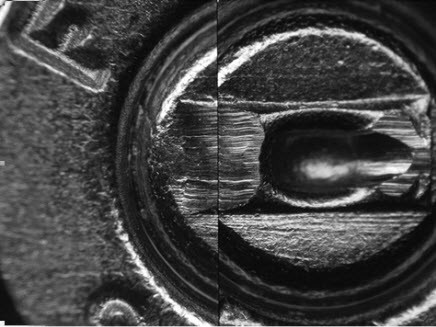
Other findings
Sometimes in case of a contact shot some amount of blood and tissue may be sucked into the barrel of the firearm which is known as back spatter.
The unburned powder or the grease found in the wound may be chemically compared to those found inside the suspect gun, which helps in identifying the firearm.
Identification of the suspect
The person suspected of firing a bullet can be identified by different methods —
Finger print recovery
The finger print of the suspect may be recovered from the firearm or the cartridge if found at the crime scene.
Dermal nitrate test
When a person fires a gun, some residue of the propellant powder, which contains nitrogen compounds, leaks from the gun and deposited on the person's hands. It can be detected by using a test called dermal nitrate test, also known as paraffin test.
A paraffin cast is taken from the suspect's hand involving the medial surface and base of thumb along with the lateral surface and base of index finger. The presence of nitrites is determined by bluish discoloration of the cast on reaction with diphenylamine.
It helps to determine whether a person fired a gun recently or not. But the test gives false negatives if there was no leakage or if the suspect used gloves or washed the hands thoroughly afterwards. It may also give false positives in the presence of other source of nitrogen compounds like urine, fertilizer etc.
Harrison and Gilroy test
This test determines the presence of metals like lead, antimony or barium in the primer mixture which may have leaked from the gun to the suspect's hand. It employs techniques like spectrophotometry, atomic absorption spectroscopy or neutron activation analysis.
Other evidences
A suspect may also be identified by other evidences found at the crime scene or elsewhere. Witnesses may also be present. It is possible for a witness to identify a suspect even in darkness by the light of the muzzle flash up to a distance of 8 yards.
Conclusion
Forensic medical examiners are required to examine the wounds on victims, either living or post-mortem. They are also required to preserve the evidences such as recovered projectiles, clothings etc. In the court they are considered as expert witnesses and can be cross-examined by the defence lawyer.
 RSS Feed
RSS Feed